X-ray pulsars
Observations of highly magnetized neutron stars (NS) in binary systems – X-ray pulsars – provide unique information about physical processes taking place in extreme conditions of strong gravity, ultra-high densities of matter and radiation, superstrong magnetic fields that are not available in terrestrial laboratories. The magnetic fields of NS in such systems reach strengths of 1012–1014 G, which exceeds the values obtained in terrestrial conditions by at least 6 orders of magnitude. Thus, X-ray pulsars are practically ideal research laboratories for the construction of theory of the interaction of a magnetic field with plasma. The development of X-ray astronomy has led to the development of a number of models for the accretion of matter onto compact relativistic objects, describing and explaining the main observational facts. At the same time, the appearance of new instruments in recent years has made it possible to determine with the highest accuracy the temporal and spectral characteristics of the observed objects at both very low and extremely high accretion rates, on time scales from milliseconds to hundreds of days. This required from our group the development and application of new methods for organizing observations and led to the discovery of hitherto unknown physical effects.
First of all, the developed methods and models allowed us to make a breakthrough in the study of magnetized NSs at low accretion rates, when the effects of plasma interaction with a magnetic field are most pronounced. One of the most striking examples of such an interaction is the so-called “propeller effect” associated with a sudden termination of accretion due to the centrifugal barrier created by the rapidly rotating NS magnetosphere.
We were able to reliably registered the “propeller effect” for several X-ray pulsars for the first time (Tsygankov et al., 2016a,Tsygankov et al., 2016b). This allowed us to develop a technique making possible not only to determine the magnetic field of NS in those systems where its direct measurement using cyclotron absorption lines is impossible, but also to obtain estimates for the structure of the magnetic field and its deviation from the dipole configuration (see Fig. 1). As a result, objects with a more complex magnetic field structure were discovered, where the quadrupole component exceeds the dipole component by a factor of 10 (Tsygankov et al., 2017a).
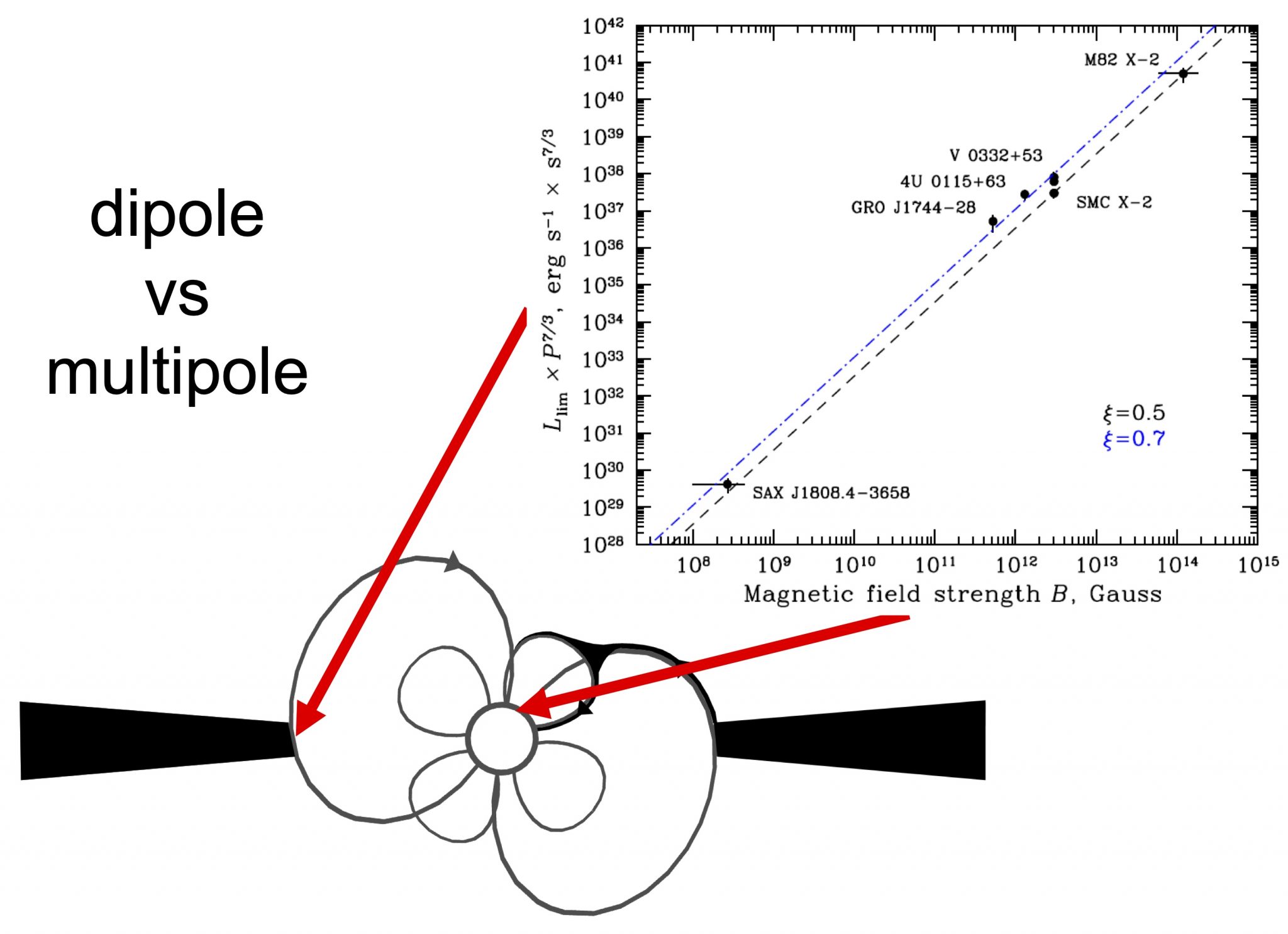
Figure 1: Observed correlation between a combination of the propeller limiting luminosity and spin period period (Y axis, represents the dipole component of the magnetic field) and independently determined magnetic field strength in the vicinity if the NS surface (X axis; represents higher multipoles of the magnetic field). Deviations from the standard dependence shown with dashed lines correspond to the deviations of the magnetic field structure from pure dipole configuration.
A long-term study of transient X-ray pulsars undertaken by our group made it possible to discover that NSs with long rotation periods do not enter the propeller regime, but instead demonstrate a state of quasi-stable accretion with a luminosity of about 1035 erg/s for a sufficiently long time (see Fig. 2 left). To explain this fact, a model of accretion from a “cold” (weakly ionized) disk was developed, on the basis of which all X-ray pulsars can be divided into two subclasses: short-period systems (with periods of less than about ten seconds) entering the propeller regime, and long-period pulsars, where the centrifugal barrier is unable to turn off accretion before the accretion disk becomes completely cold and stable (Fig.2 right; Tsygankov et al., 2017b). These predictions were confirmed by observations of several dozen objects with luminosities of 1033-1035 erg/s using the Chandra, XMM-Newton and Swift observatories (Tsygankov et al., 2017c).
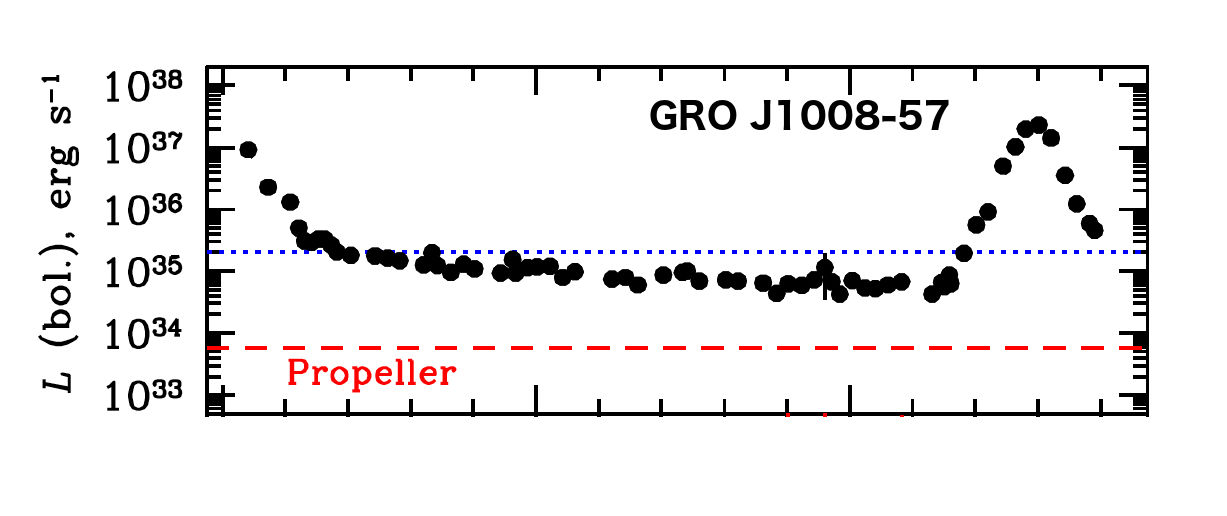
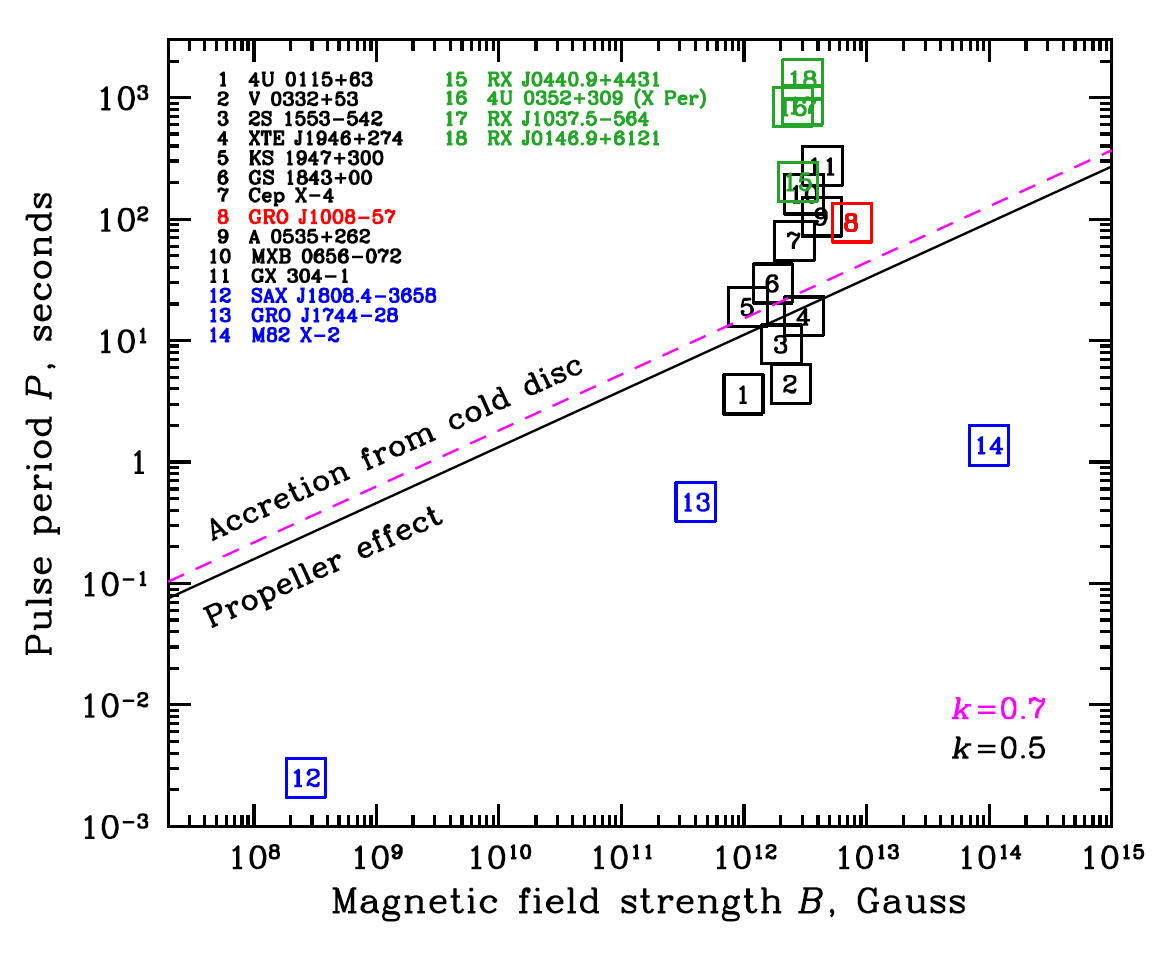
Figure 2: Left: Bolometric luminosity of GRO J1008-57 (spin period around 95 s) obtained by the Swift/XRT telescope between two consequent outbursts. The dashed red and dotted blue lines show the predicted luminosity Lprop for the transition to the propeller regime and the observed transition to the low-level stable accretion regime, respectively. Right: Collection of some known X-ray pulsars on the B-P plane. The solid and dashed lines correspond to the prediction of our model and separate sources where the propeller regime is possible from sources with stable accretion from the cold disc.
We also initiated spectral studies of X-ray pulsars in a wide range of energies at low luminosities using the NuSTAR observatory. As a result, it has been recently discovered that the transition of X-ray pulsars to the low luminosity state is accompanied by a dramatic spectral changes (Tsygankov et al., 2019a, Tsygankov et al., 2019b). Namely, the typical power-law-like spectrum with high energy cutoff transforms into a two-component structure with a possible cyclotron absorption feature on top of it. It was proposed that these spectral characteristics can be explained qualitatively by the emission of cyclotron photons in the atmosphere of the neutron star caused by collisional excitation of electrons to upper Landau levels and further comptonization of the photons by electron gas. The latter is expected to be overheated in a thin top layer of the atmosphere (Mushtukov et al., 2021b, see Fig. 3).
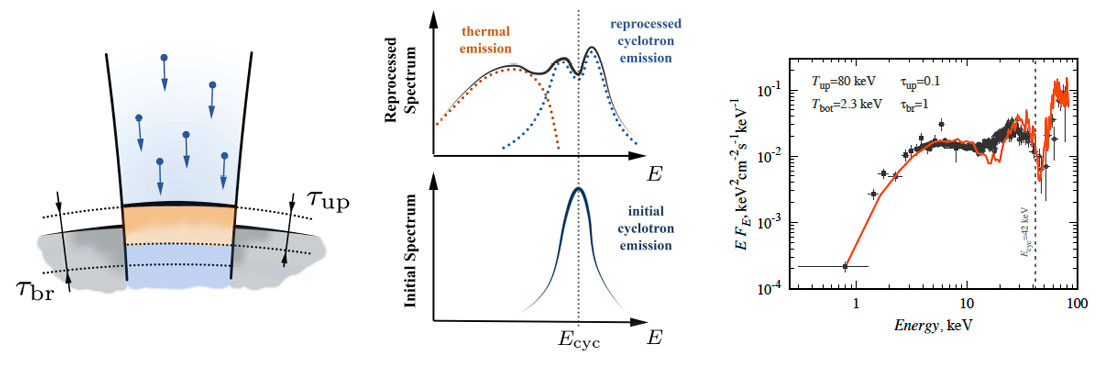
Figure 3: Proposed mechanism of the two-component spectrum formation in highly magnetised NSs. The results of our numerical simulations are tested against the observational data of X-ray pulsar A 0535+262.
Along with studies of NSs at low accretion rates, our group also succeeded in quantitatively explaining the possibility of supercritical accretion onto magnetized NSs including in the recently discovered pulsating ultra-bright X-ray sources, whose luminosity reaches 1040-1041 erg/s, i.e. exceeds the Eddington limit for NS by 100-1000 times. The model of an accretion column was developed, in which it was quantitatively shown that a decrease in the Compton scattering cross section in magnetic fields leads to the unique ability of highly magnetized NSs to exceed the Eddington limit by many times, which requires magnetic field strengths of the order of 1013-1014 G (Mushtukov et al., 2015a, Mushtukov et al., 2015b). Observations of several ultra-bright pulsars made it possible to successfully verify the developed model, including results from observations of the propeller effect in the first pulsating ULX M82 X-2 (see Fig. 4).
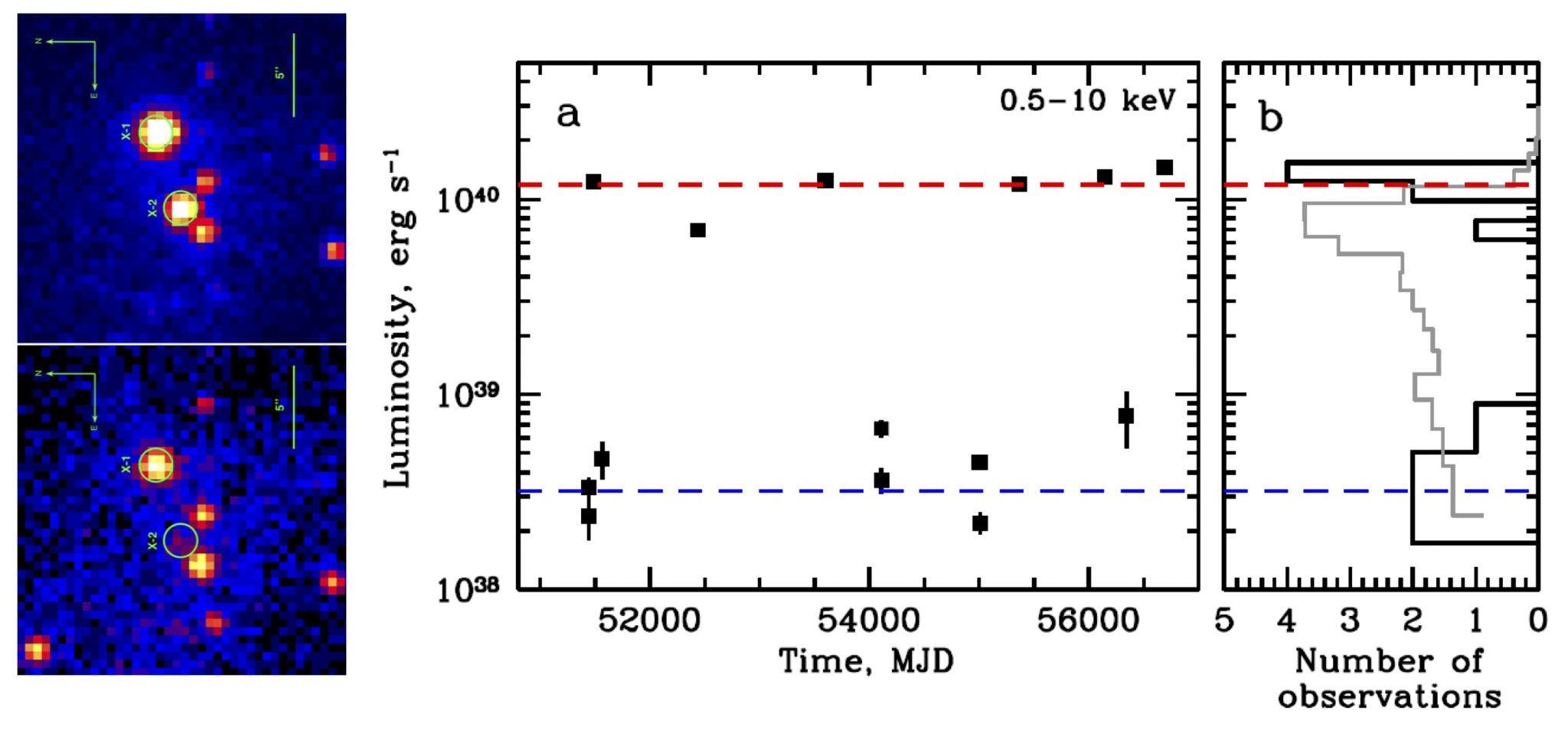
Figure 4: Light curve of M82 X-2 obtained by the Chandra observatory and bimodal distribution of individual observations over luminosities.
Selected publications:
- Suleimanov V.F., Forsblom S.V., Tsygankov S.S., Poutanen J., et al.,
X-ray polarimetry of the accreting pulsar GX 301−2,
2023, A&A, 678, A119 - Doroshenko V., Poutanen J., Heyl J., Tsygankov S.S., Berdyugin A.V., …, Forsblom S.V., …, Kravtsov V., Loktev V., …, Nitindala A.P., …, Veledina A., et al.,
Complex variations of X-ray polarization in the X-ray pulsar LS V +44 17 / RX J0440.9+4431,
2023, A&A, 677, A57 - Mushtukov A.A., Tsygankov S.S., Poutanen J., …, Forsblom S.V., et al. (IXPE collaboration),
X-ray polarimetry of X-ray pulsar X Persei: another orthogonal rotator?
2023, MNRAS, 524, 2004–2014 - Tsygankov S.S., Doroshenko V., Mushtukov A.A., Poutanen J., et al.,
X-ray pulsar GRO J1008−57 as an orthogonal rotator,
2023, A&A, 675, A48 - Malacaria C., Heyl J., Doroshenko V., Tsygankov S.S., Poutanen J., Forsblom S.V., et al.,
A polarimetric-oriented X-ray stare at the accreting pulsar EXO 2030+375,
2023, A&A, 675, A29 - Forsblom S.V., Poutanen J., Tsygankov S.S., et al.,
IXPE observations of the quintessential wind-accreting X-ray pulsar Vela X-1,
2023, ApJ Letters, 947, L20 - Tsygankov S.S., Doroshenko V., Poutanen J., Heyl J, Mushtukov A.A., Caiazzo I, Di Marco A., Forsblom S.V. et al.,
The X-ray polarimetry view of the accreting pulsar Cen X-3,
2022, ApJ Letters, 941, L14 - Marshall H.L., Ng M., Rogantini D., Heyl J., Tsygankov S.S., Poutanen J., Costa E., Zane S., Malacaria C., et al.,
Observations of 4U 1626-67 with the Imaging X-ray Polarimetry Explorer,
2022, ApJ, 940, 70 - Doroshenko V., Poutanen J., Tsygankov S.S., et al.,
Determination of X-ray pulsar geometry with IXPE polarimetry,
2022, Nature Astronomy, 6, 1433–1443 - Bachetti M., Heida M., Maccarone T., Huppenkothen D., Israel G.L., Barret D., Brightman M., Brumback M., Earnshaw H.P., Forster K., Fürst F., Grefenstette B.W., Harrison F.A., Jaodand A.D., Madsen K.K., Middleton M., Pike S.N., Pilia M., Poutanen J., Stern D., Tomsick J.A., Walton D.J., Webb N., Wilms J.,
The extreme mass transfer and high magnetic field of the first ultraluminous pulsar M82 X-2,
2022, ApJ, 937, 125 - Mönkkönen J., Tsygankov S.S., Mushtukov A.A., Doroshenko V., Suleimanov V.F., Poutanen J.,
Constraints on the magnetic field structure in accreting compact objects from aperiodic variability,
2022, MNRAS, 515, 571–580 - Mushtukov A.A., Suleimanov V.F., Tsygankov S.S., Portegies Zwart S.,
Spectrum formation in X-ray pulsars at very low mass accretion rate: Monte Carlo approach,
2021b, MNRAS, 503, 5193-5203 - Mushtukov A.A., Portegies Zwart S., Tsygankov S.S., Nagirner D.I., Poutanen J.,
Pulsating ULXs: large pulsed fraction excludes strong beaming,
2021a, MNRAS, 501, 2424-2429 - Tsygankov S. S., Rouco Escorial A., Suleimanov V. F., Mushtukov A. A., Doroshenko V., Lutovinov A. A., Wijnands R., Poutanen J.,
Dramatic spectral transition of X-ray pulsar GX 304-1 in low luminous state,
2019a, MNRAS Letters, 483, L144-148 - Tsygankov S. S., Doroshenko V., Mushtukov A. A., Suleimanov V. F., Lutovinov A. A., Poutanen J.,Cyclotron emission, absorption, and the two faces of X-ray pulsar A 0535+262,
2019b, MNRAS Letters, 487, L30-34 - Tsygankov S.S., Doroshenko V., Mushtukov A.A., Lutovinov A.A., Poutanen J.,
On the magnetic field of the first Galactic ultraluminous X-ray pulsar Swift J0243.6+6124,
2018, MNRAS Letters, 479, L134-L138 - Mushtukov A.A., Tsygankov S.S., Suleimanov V.F., Poutanen J.,
Ultraluminous X-ray sources as neutrino pulsars
2018, MNRAS, 476, 2867-2873 - Tsygankov S.S., Doroshenko V., Lutovinov A.A., Mushtukov A.A., Poutanen J.,
SMC X-3: the closest ultraluminous X-ray source powered by a neutron star with non-dipole magnetic field,
2017a, A&A, 605, A39 - Tsygankov S. S., Mushtukov A. A., Suleimanov V. F., Doroshenko V., Abolmasov P. K., Lutovinov A. A., Poutanen J.,
Stable accretion from a cold disc in highly magnetized neutron stars,
2017b, A&A, 608, id.A17 - Tsygankov S. S., Wijnands R., Lutovinov A. A., Degenaar N., Poutanen J.,
The X-ray properties of Be/X-ray pulsars in quiescence,
2017c, MNRAS, 470, 126-141 - Tsygankov S. S., Lutovinov A. A., Doroshenko V., Mushtukov A. A., Suleimanov V., Poutanen J.,
Propeller effect in two brightest transient X-ray pulsars: 4U 0115+63 and V 0332+53,
2016a, A&A, 593, id.A16 - Tsygankov S.S., Mushtukov A.A., Suleimanov V.F., Poutanen J.,
Propeller effect in action in the ultraluminous accreting magnetar M82 X-2,
2016b, MNRAS, 457, 1101-1106 - Mushtukov A.A., Tsygankov S.S., Serber A.V., Suleimanov V.F., Poutanen J.,
Positive correlation between the cyclotron line energy and luminosity in sub-critical X-ray pulsars: Doppler effect in the accretion channel,
2015, MNRAS, 454, 2714-2721 - Mushtukov A.A., Suleimanov V.F., Tsygankov S.S., Poutanen J.,
On the maximum accretion luminosity of magnetized neutron stars: connecting X-ray pulsars and ultraluminous X-ray sources,
2015, MNRAS, 454, 2539-2548 - Walter R, Lutovinov A.A., Bozzo E., Tsygankov S.S.,
High-mass X-ray binaries in the Milky Way. A closer look with INTEGRAL,
2015, Astronomy and Astrophysics Review, 23, 99 - Mushtukov A.A., Suleimanov V.F., Tsygankov S.S., Poutanen J.,
The critical accretion luminosity for magnetized neutron stars,
2015,MNRAS, 447, 1847-1856 - Poutanen J., Mushtukov A.A., Suleimanov V.F., Tsygankov S.S., Nagirner D.I., Doroshenko V., Lutovinov A.A.
A Reflection Model for the Cyclotron Lines in the Spectra of X-Ray Pulsars,
2013, ApJ, 777, 115